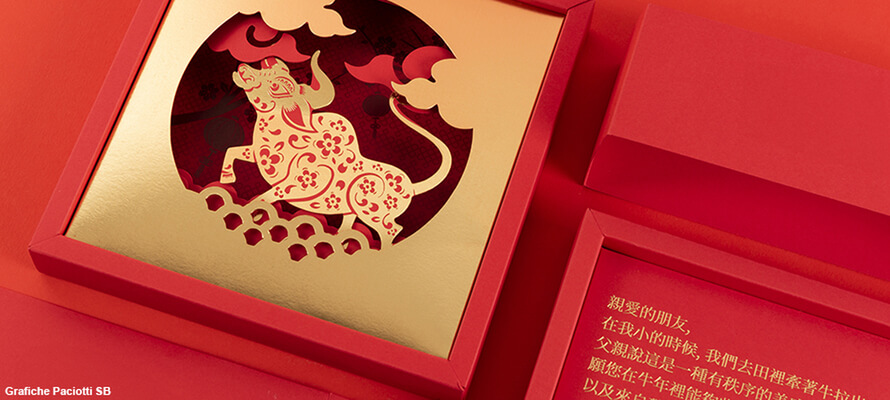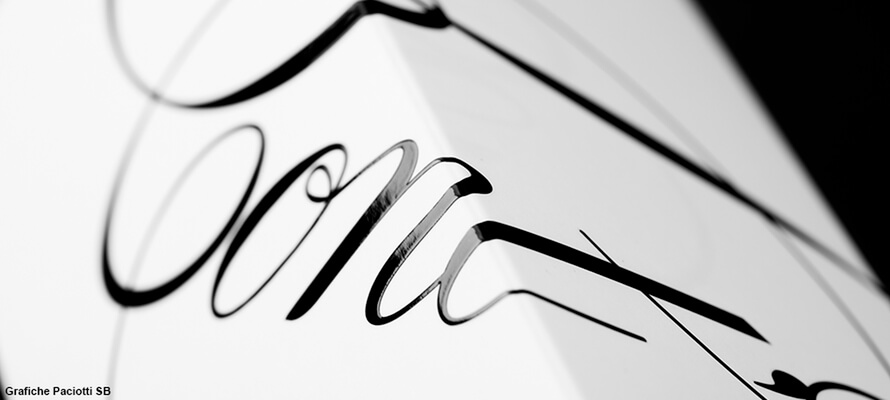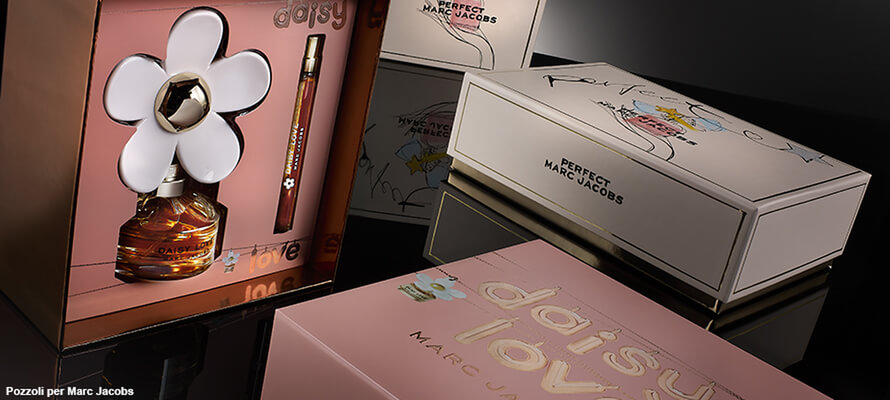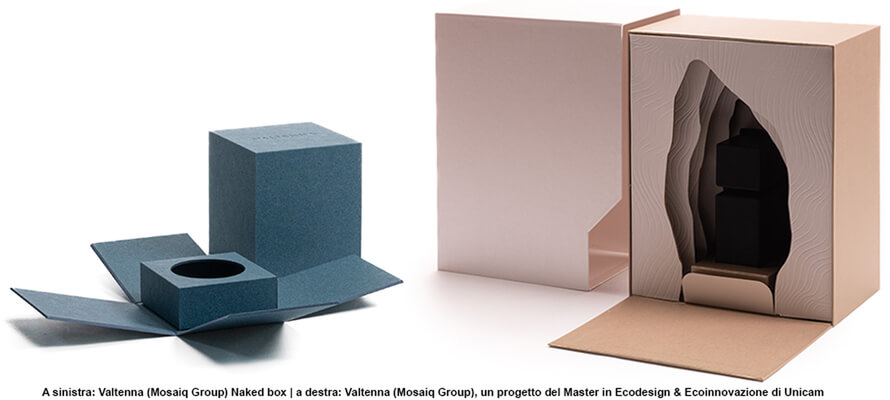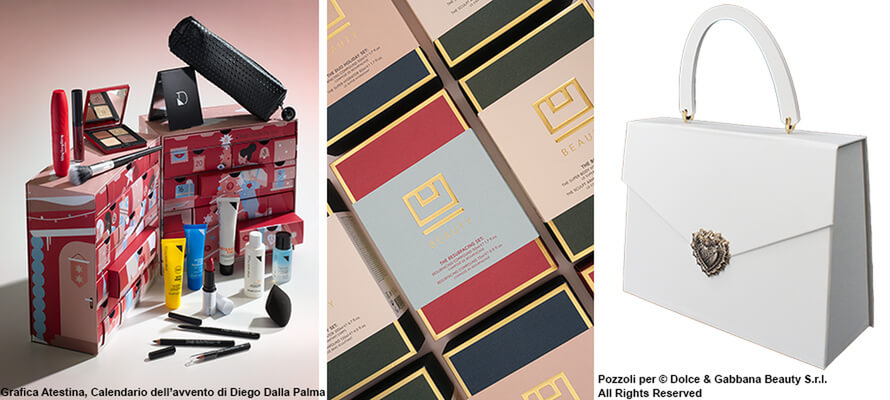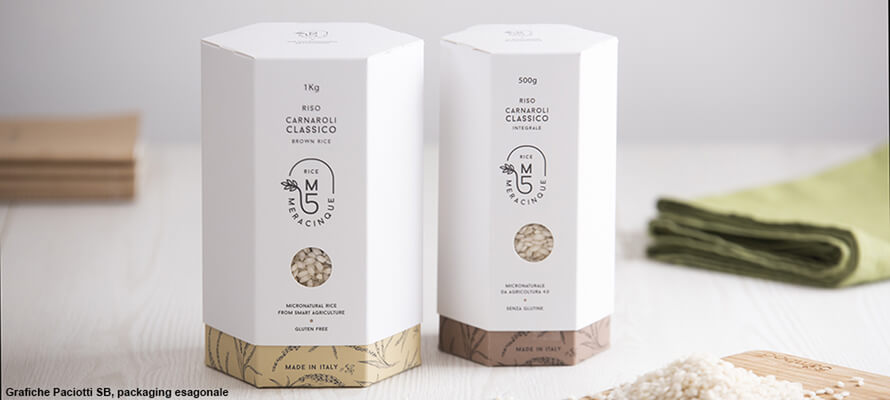The rules of a perfect box set
What are the key elements of luxury packaging, and what do you need to know when designing or commissioning a high-end box? We asked four Italian companies specialising in luxury packaging: Grafica Atestina, Grafiche Paciotti SB, Pozzoli and Valtenna (Mosaiq Group).
By Michela Pibiri | PRINTlovers 103
Defining the perimeter of luxury packaging is complex: several elements contribute to this definition, but they are not immutable over time - far from it! - and not all of them are tangible. Even less straightforward is knowing the aspects required to make it, satisfying the most demanding market demand par excellence. And this is where we begin our investigation that involved Barbara De Poli, CEO and Marketing Manager of Grafica Atestina, Fabio Bracciotti, Sales Manager of Valtenna, Michele Valentini, Project Manager of Grafiche Paciotti SB and Gianfranco Vicini, Quality and R&D Director of Pozzoli. These Italian companies in four different regions - Veneto, Marche, Umbria and Lombardy - have made high-end their core business.
It is luxury if...
“Belonging to the luxury segment is an attribute of the customer, rather than of the article,” says Fabio Bracciotti of Valtenna. “Prestigious brands that, in addition to undisputed product quality, intend to create a unique and differentiating shopping experience, need packaging that fulfils specific requirements in terms of morphology, unboxing rituals, ethical, tactile, auditory, visual attributes”. “At the heart of luxury packaging is its interaction with the consumer. The pack must provoke an emotion; it must accompany the desire of the beholder. A luxury pack can also be recognised by its perfect connection with the product it contains,” emphasises Barbara De Poli of Grafica Atestina. “It must be beautiful, functional, give a clear and correct message and be immediately distinguishable from the competition. The choice of materials and printing techniques dominates the classification in the sector, but aspects such as customisation and craftsmanship are no less dominant. “The choice falls both on prestigious materials - i.e. pure cellulose, and towards the latest eco-innovations,” says Pozzoli’s Gianfranco Vicini. “Concerning printing techniques, normally luxury packaging does not involve a simple four-colour process, but additional Pantone colours. Special finishes and enhancements then make the visual impact extremely eye-catching”. For Michele Valentini of Grafiche Paciotti SB, “the use of high-quality raw materials such as paste-dyed cardboard, embossed paper and high-quality coating materials; the use of advanced printing and finishing technologies that allow work of great precision and definition, including hot stamping and multidimensional embossing,” are fundamental. Other indicators are attention to detail, absence of defects, durability, additional craftsmanship, and final inspection of individual pieces. Craftsmanship is a distinguishing aspect because, despite the very high standards of the machinery, certain aspects, such as the insertion of accessories and the care of glueing, require manual intervention. And the cost? It is undoubtedly an indicator of luxury packaging, not as a defining feature per se but as a “consequence that derives from a technical and design development that is usually long and in-depth, often requiring customised recipes for the line or the brand that is being represented,” concludes Barbara De Poli.
The evolution of luxury shapes
But what are the most popular types of luxury packaging? “They range from “simple” cases, defined as such in terms of structure but certainly not in terms of production, to the more complex rigid boxes,” explains Gianfranco Vicini. “In beverages, we have champagne boxes, but also cases for whisky and fine wines. Sometimes, these are linear cases, i.e. cases in which only one flap is glued on, but the printing is of a very high standard. Our luxury customers, for example, demand that productions made at different times keep a uniform colour between them. The Pantone colours that distinguish the brands are very strict and cannot have alterations beyond ΔE >1”. “The most popular types considered to be luxury, irrespective of the product they contain, are the boxes with the most particular and customised shapes, in stretched cardboard or laminated and lined, with special openings or bottom lids, with interiors shaped according to the contents,” says Barbara De Poli. But in addition to the archetypal luxury constructions, such as circular hatboxes and caskets, a new approach is emerging: “At Valtenna,” says Fabio Bracciotti, “we look beyond the traditional classifications of the sector, which tend to place the most onerous construction techniques as “luxury packaging”. Some luxury brands are approaching simplified paper constructions in the light of an ethical, responsible shopping experience far removed from the unscrupulous opulence of other historical moments. Experimentation and new geometries can also represent innovative content”. Michele Valentini also notes a paradigm shift: “We are noticing an evolution in the concept of luxury that includes the use of sustainable materials and the search for short, controlled supply chains: “luxury” understood not only in the aesthetic sphere but associated with a broader concept that involves the brand in all its activities”.
Innovation and experimentation
One of the main constraints of the industry is standardisation, which allows multiples to be obtained in large quantities and with the same characteristics. If the most classic shapes we are used to associating with packaging are the cube and the parallelepiped, anything that goes beyond that implies greater complexity in terms of design and production. “Now though, technology,” says Barbara De Poli, “allows us to create cylindrical shapes, pyramidal shapes, hexagonal-based prisms and much more. And by combining these shapes, we create genuinely complex objects”. “The most innovative shapes,” says Gianfranco Vicini, “involve combining different materials. We at Pozzoli have created various packaging in which the structure sees the coexistence of cardboard and wooden elements. Purely luxury products have repeatedly been embellished with refined metal trimmings. We have been asked to include technological aspects such as LEDs and semi-automatic opening devices in our packs.
“Customisation and experimentation aim to go beyond industry standardisation and produce novel solutions,” says Fabio Bracciotti. “The real challenge is the ability to develop flexible systems: in addition to “soft” customisations linked to visual or material aspects, a flexible industry must be able to practise “hard” customisations, adapting production techniques to produce novel geometries or constructions. For example, our “Naked” line consists of “uncoated” rigid constructions. This allows for 90° sharp edges with essential geometries and natural materials. Although seemingly simplistic, the production process is different from the rigid coated one (where it is the coating that holds the box components together), and we are one of the very few companies in Europe to have adopted these material-reducing technologies. The same principles have guided the development of “light-core” techniques through which it is possible to reduce weight and cellulose consumption by up to 30%”. Michele Valentini also emphasises the innovative thrust of sustainability: “We are realising how attentive luxury is to sustainable choices with a low environmental impact. Our research is currently focused on creating a box that can best combine the aesthetics and finish of a wrapped box through the use of ever lighter materials with as little glue as possible”.
Beautiful inside
We have talked about the aesthetic and sensory impact of luxury packaging, but the design of the inside of the box is equally important since the primary function of packaging is to protect the product. The main trend is the total replacement of thermoformed plastics and pre-cut foam rubber with cellulosic materials, which all four companies confirm. “We have developed production techniques,” says Fabio Bracciotti, “to make single-material cellulose-based interior fittings. So, we have entirely recyclable packaging that is produced from renewable materials at the end of its life cycle. The precision of the internal shaping allows us to fulfil the functions of shockproofing and protecting the products”. Gianfranco Vicini confirms that “the interior of a rigid box has changed from thermoformed to cardboard. The complexity lies in the fact that plastic has a sealing memory and is, therefore, deformable by returning to the same position.
In contrast, cardboard does not have the same characteristics because it stays that way once deformed. As Pozzoli, we offer different solutions such as the Pulp-tray - cardboard pressed in a particular mould - or the purely converting solution with rigid cardboard or microwave”. In addition to the choice of material, it is essential to study the intended use in detail. Barbara De Poli says: “To design the interior, you need to know the product to be transported; from its shape to its weight, from its material to the position it must maintain, lying horizontal or vertical. You also need to analyse the stresses to which it will be subjected and conduct the necessary crash tests”. Michele Valentini adds: “We also need to know the level of visibility that the product will have so we can propose the best possible placement solution. To sum up, it can be said that even the interior design will have to take care of every detail, from the ease of insertion and removal of the product to the tightness in its housing and the proportions and aesthetics of the cut”.
Design, collaboration and customisation
How should the design of a luxury pack be approached? Almost all requests come from companies that want to stand out. This is why, as with tailor-made work, direct collaboration between client, designer, and supplier is crucial. And that”s not all: working as a team can reduce revisions in the later stages and guide development by considering critical aspects such as cost, processes, compatibility of workmanship, materials and everything that contributes to making the product industrially replicable. “In our experience,” says Michele Valentini, “there is no real ”standard process” in design, but the briefing must be well set out because it is essential to understand the customer”s needs. At the same time, it is important to have experience with the materials used to have the working processes under control right from the concept phase”. For Grafica Atestina, the pack must be a tailor-made product using state-of-the-art industrial techniques to guarantee quality and perfection. Says Barbara De Poli: “To achieve the objective, we evaluate even very complex geometric shapes and accompany the customer in the sensory aspect of materials, colours and the care of the finishes. Then our technical and R&D department works on the proposals and creates prototypes for the customer to test”. “The first stages of the design process are those in which innovation hypotheses are put forward and the foundations for packaging development are laid,” says Fabio Bracciotti. “Usually, they involve brand and agency, but we are firmly convinced that a producer”s involvement at this stage can make a significant contribution in terms of feasibility and sprinkle the creative processes with technical content so that the executive design is as close as possible to the creative concept.” “The technical aspects to be considered depend very much on the packaging chosen, but the collaboration with the designer or, in any case, the customer”s contact person for us at Pozzoli is decisive right from the initial stage. It is also essential for the designer to have a definitive prototype in their hands so that they are clear about the construction and any problems that may arise due to construction tolerances.”
Sustainable luxury
Brands are becoming more and more environmentally conscious, and this opens up new challenges for the industry, which has to adapt on many levels. But when can luxury packaging be defined as sustainable? “Increasingly avoiding the use of foams, plastics, and magnetic closures is what the luxury packaging market is asking of us,” says Michele Valentini. “Lightness, and the consequent reduction of raw materials used, also plays an important role. As Grafiche Paciotti, we have started a process of sustainability that has allowed us to become a B-Corp and to produce Prima: our 100% recycled paper from processing waste”. “At Valtenna,” says Fabio Bracciotti, “we have been committed for over a decade to developing products designed to produce environmental benefits, selecting renewable raw materials, providing solutions that facilitate the recovery of materials at the end of the cycle and reduce material consumption, adopting printing processes with water-based inks and reducing the use of chemical agents, containing energy consumption and preferring renewable sources, creating wealth for the local areas, enhancing internal resources and encouraging individual growth processes, experimentation and innovation, and supporting highly qualified training projects with schools and universities to create new skills of value for the company and the community. A mature approach to sustainability, in our view, is a systemic vision that is not limited to the product but extends to the industry and the extended community of stakeholders”. “Among the many aspects of a sustainable pack,” says Barbara De Poli, “are the recyclable and compostable materials, recycled paper or paper from certified supply chains, and the compostable bioplastics and innovative ecological materials produced with natural or vegetable bases used in its production. The pack size and the characteristics chosen during the design process can significantly impact the product”s sustainability and waste reduction by increasing the layouts, optimised die-cuts and simple graphics”. “Luxury packaging,” concludes Gianfranco Vicini, “can be considered sustainable when the materials used are primarily recyclable or compostable. At Pozzoli, for example, if a customer requires a metallised effect, we offer environmentally friendly plastics such as PLA or a transfer solution in which only the metallisation effect is transferred onto the paper, while the film on which it was located is removed, recovered and reused. And our sustainable luxury packaging solutions often include a “second life”; in other words, reuse once its initial function is over”.
